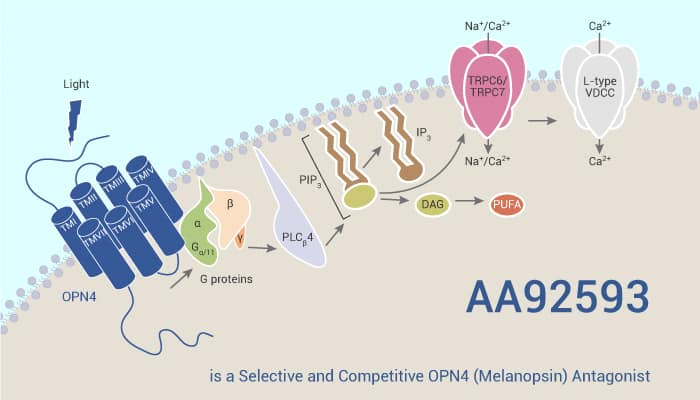Melanopsin (OPN4) is a photopigment in a small part of intrinsically photosensitive ganglion cells (ipRGC) of the mammalian retina. Meanwhile, Melanopsin is a photosensitive pigment, which is encoded by the OPN4 gene. Mutations in the OPN4 gene can lead to clinical diseases, such as seasonal affective disorder (SAD). Nonetheless, the ganglion cells containing melanopsin showed light adaptation and dark adaptation. They adjust their sensitivity based on a recent light history. Specifically, the ipRGC helps the brain and body respond to light in a variety of ways. Melanopsin photoreceptors are sensitive to a series of wavelengths and reach the peak absorption at about 480nm blue wavelength.
Besides, Melanopsin was expressed in a small number of retinal ganglion cells. These cells had ipRGC and had peak response sensitivity in the blue spectrum. Melanopsin regulates the biological clock, neuroendocrine hormone, pupil diameter, sleep, wakefulness, photophobia, and migraine. Moreover, retinal ganglion cells (mRGC) expressing melanopsin in the mammalian retina account for 2.5% of the total number of RGCs. Inhibition of the melanopsin can prevent the light-induced aggregation of melanin in melanocytes. Today, we will introduce a selective and competitive OPN4 (melanopsin) antagonist, AA92593.

AA92593 is a Selective and Competitive OPN4 (Melanopsin) Antagonist.
At first, AA92593 is present in the retinal binding pocket of melanopsin, resulting in retinal displacement. Furthermore, this may trigger downstream signal transduction and eventually increase the expression of Per1.
Secondly, AA92593 is specific because it competes with retinol for the retinol-binding site of melanopsin, which is very different from other opsins. Interestingly, AA92593 can increase the expression of a-MSH and induce melanin to disperse in melanocytes, thus darkening embryos. Importantly, AA92593 exhibits an IC50 of 665 nM in CHOOpn4 cells.
Thirdly, AA92593 with 30 mg/kg by IP 20 min prior to PLR measurement attenuated pupil constriction in response to light (1013 ph.cm−2.s−1) by ~50%. Particularly, AA92593 is able to decrease IOP in rabbits living under normal light conditions. Obviously, AA92593 produces an increment in melatonin levels resulting in a drop of IOP.
Finally, AA92593 is a selective and competitive OPN4 antagonist.
References:
Maria Nathália Moraes, et al. Sci Rep. 2017 Oct 25;7(1):13977.
Kenneth A Jones, et al. Nat Chem Biol. 2013 Oct;9(10):630-5.